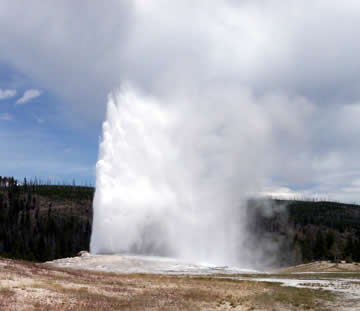The visible water supply in lakes and rivers represents but a small portion of the water of a continent; the rest lies hidden in natural reservoirs underground. Indeed, most lakes and rivers would dry up if they depended solely upon precipitation.
It is the continuing supply from the underground sources that keeps lakes high and rivers running, even during periods of drought.
The water of these subterranean storehouses is constantly replenished by the moisture of rain and melting snow that seeps downward through the soil, through porous rock and through crevices in rock. It may flow for long distances underground or emerge in the springs that flow into streams, rivers and lakes, its final destination being the sea.
The only contact most people ordinarily have with this hidden water comes when they drill a well. But underground waters are capable of highly visible displays. Geysers, consisting of tons of hot water spouting up out of the ground, are the most arresting of these effects.
The world's most spectacular geysers are found in Iceland, New Zealand and America's Yellowstone National Park, on a high plateau among the Rocky Mountains in the state of Wyoming.
At Yellowstone there are at least 10,000 geysers, hot pools, pots of boiling mud and fumaroles (steam vents).
 Several special conditions are necessary for the formation of a geyser. First, seething molten material (volcanic magma) must exist under local layers of surface rock. Leading from the heated subterranean rock to the surface there must be narrow channels with walls strong enough to endure the explosive force of the geyser. Finally, there must be an underground supply of water that reaches the magma in such a way that it is heated and forced upward.
Several special conditions are necessary for the formation of a geyser. First, seething molten material (volcanic magma) must exist under local layers of surface rock. Leading from the heated subterranean rock to the surface there must be narrow channels with walls strong enough to endure the explosive force of the geyser. Finally, there must be an underground supply of water that reaches the magma in such a way that it is heated and forced upward.
The primary difference between a hot spring and a geyser is the degree to which this water has been heated by the molten rock; geysers occur only when the heat and pressure are sufficient to produce steam, and hence cause explosive effects.
While geysers and hot springs appear to be spread in a random fashion throughout Yellowstone's 3472 square miles, they are actually arranged in definite belts. These belts occur along faults or fractures where sections of rock move up, down or sidewise in relation to adjacent sections. These faults provide passageways for the escape of steam and hot water trapped at subterranean levels. As sources of heat, Yellowstone's geysers have created favorable winter living conditions for plants and animals, which cluster around them.
Many bears have located their dens near geysers, and numerous birds winter in these same warm areas. Ducks, in particular, are often seen in winter in the pools of water kept free of ice by the warm water issuing from the geysers. The temperature of the Yellowstone River rises by an average of six degrees as it flows through the geyser area, and in that stretch of the river, trout are active all winter long.
Geyser water is extremely rich in dissolved minerals - it is the kind of water commonly called "hard water." Anyone familiar with hard water knows that a coating of minerals soon forms on the inside walls of kettles and pans used to boil this liquid. This residue is left by the water when it evaporates.
Precisely the same sort of thing occurs at the base of the jet of a geyser. Formations of rock have been created in shapes that suggest cauliflowers, sponges, chairs, flowers and necklaces. Sometimes terraced formations are created, as at Yellowstone's Mammoth Hot Springs, by water flowing down hillsides. The brilliant streaks of color in these deposits are due largely to the great variety of minerals carried to the surface by the geysers. Some of the coloration, though, is caused by algae that have adjusted to living at high temperatures.
The water trapped under pressure at the bottom of the tube grows hotter and hotter. Eventually its temperature rises far above the normal boiling point of water. The vapor produced is prevented from escaping as steam by the overlying mass of cooler water. Finally the water in the upper part of the column warms and expands, some of it welling up out of the mouth of the geyser. The escape of this water abruptly decreases the pressure on the superheated waters at bottom, which change to steam. The sudden expansion of the superheated water into steam occurs in a powerful explosion that forces all the water and vapor up out of the geyser.
The geyser almost always gives advance warning of an eruption: a short spurt, then a graceful column begins to rise. At first it seems to grow with great effort, but soon a jet shoots upward, playing at heights between 115 and 150 feet. At its crest the jet is broken by the breeze. The water unfurls into a dazzling shower of droplets that, capturing the sunlight, shimmer with the colors of the rainbow. The full display lasts between two and five minutes, expelling as much as 12,000 gallons of water during a single eruption.